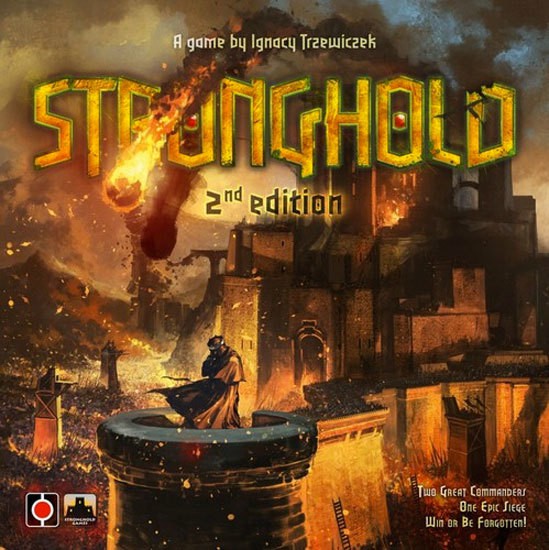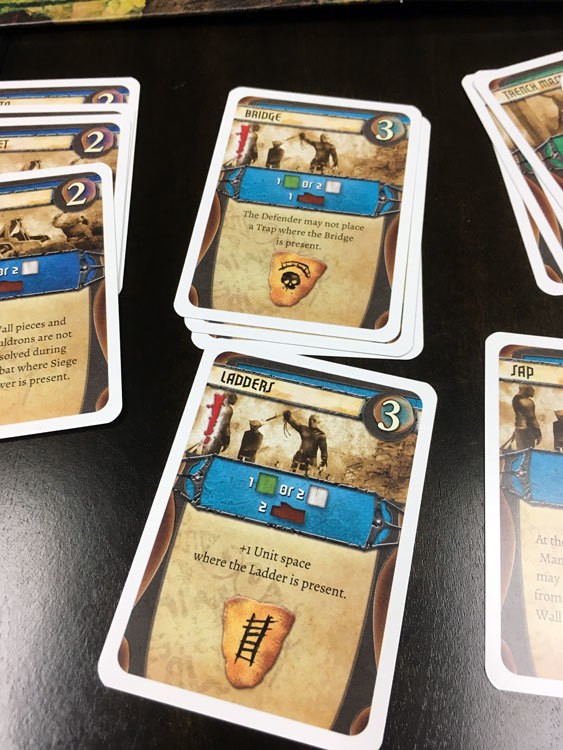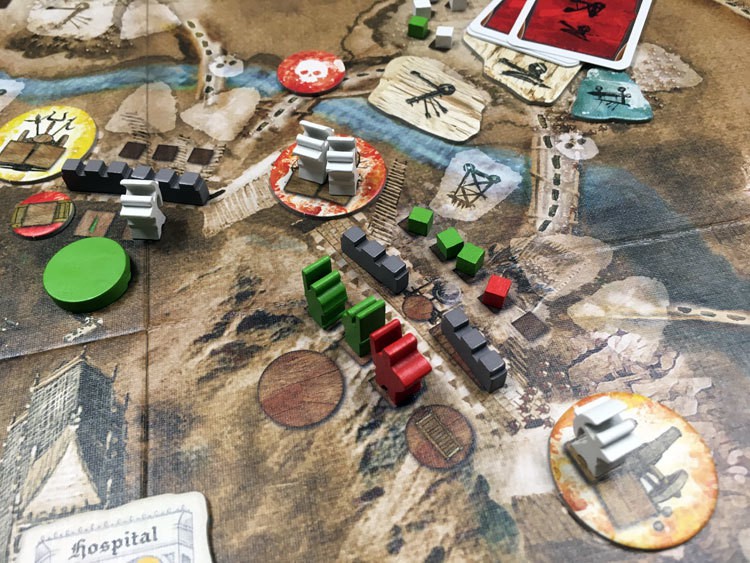 A second edition is most often a chance for a publisher to take a game received well for its concepts and refine it to update the play style to fit a new audience, or get it closer to perfection. Since Stronghold is a two-player only affair with much the same play style, it is to be assumed that Portal and Stronghold games intend for the latter.
A second edition is most often a chance for a publisher to take a game received well for its concepts and refine it to update the play style to fit a new audience, or get it closer to perfection. Since Stronghold is a two-player only affair with much the same play style, it is to be assumed that Portal and Stronghold games intend for the latter.
Stronghold (hereafter assumed to be 2nd Edition) is a game pitting two opposing forces against each other in a medieval setting. One invader player (the invader) is attacking a fortress, defended by the defending player (the defender). According to the box, Stronghold takes 90 or more minutes to play. This play time is probably accurate with equal, experienced opponents. Initial plays can take double this time. If inexperienced defenders play, the game time could be half the time.
Game Overview:
Stronghold includes a large double-sided sheet containing a prologue to the theme of the game. An invading force of goblins, orcs and trolls is attacking a fortress populated with two heroes, veteran warriors, soldiers and marksmen. The invader is attempting to use a combination of troops, siege engines and spells to send units along discrete paths to the walls and overcome the forces of the defender.
The management of this defense by the defender uses time units as resources to shore up the defense of the walls with archers, soldiers, and castle structures. If the defender can last seven game rounds without a wall breach, the defender wins. If a wall is breached, the invader wins immediately.
Game Components:

Inside the box are a veritable horde of wood components. The defender receives meeples representing fighting units which are very nicely detailed and two discs (red and green) representing the heroes. The invader’s units, however, are the tiniest cubes possible. Despite being unthematic like the defender’s pieces, these cubes are, at best, 3 mm wide and look miniscule in comparison on the game board. The assumed reason for this choice is cost saving because the invader unit spaces can clearly accommodate 5 mm cubes (the smallest usual size in board games).
The cards are arguably one of the most well made of all the components in the game. The style favors visuals to explain the cards’ effects while text is used sparingly. They definitely hold up well to repeated plays.
The game board itself is done in a very illustrative style which definitely helps draw players into the theme, but it also entreats confusion to how units move (specifically for the defender). This would not pose a significant problem if the necessary assistance was illustrated better in the rulebook. A released FAQ has more detail, but without seeking this out, the included rules (version 1.2 in the copy reviewed) have an unnoticeable error about movement. The included rulebook, while it is beautiful, includes enough confusing issues, and a few errors, that the release of an extensive FAQ was necessary.
It is safe to say that by itself, Stronghold is not a typical game and it demands close attention to the rules of play to understand the flow and how to get the most out of the experience. The rules include many examples but still don’t answer enough questions that arise. Players will almost assuredly need to refer to other sources, including answers for rules questions in online forums. Overall, one of the most opportune ingredients to successful instruction and enjoyment of the game hampers players and makes them wonder if this is truly a second edition.
How to Play:
Stronghold’s setup is fairly straightforward. The defender need only place units on the starting spaces and draw a few cards. The invader’s setup consists of initial unit placement, but more importantly, the player draws a series of cards from an action deck and lays them out. A selection of nine cards, numbered from 1 to 6, represent the actions the invader can take in order leading up to the “assault”, which is the resolution of all combat. As the game develops, the invader can choose which action cards from the deck to include, and which to pull out.
The invader then controls the flow of play by deciding which action cards to resolve and some choice as to how the defender receives resources. For example, the invader might elect to gather resources. This gives the invader some resources, but it also gives the defender a unit of time (represented by hourglasses). The defender spends these units of time as each action card is resolved, after the invader completes their action. Different groups of action cards represent the different preparatory steps necessary for the assault. One group gives attacking units experience and training. Another group prepares siege machines. And yet another group offers the preparation of spells.

The defender, meanwhile, has their own groups of actions to spend time units on, centered around the buildings in the middle of the fortress. As an example, the defender can move units around the fortress, allocate time to train troops, prepare defensive structures, lay traps, or cause siege weapons to malfunction. The defender must completely spend all time units before the invader takes their next action, limiting the defender to only the knowledge from what they have seen from the invader thus far that round.
At the end of all planning comes the maneuvers action. With this, the invader moves troops closer to the fortress, possibly even right up to the walls. This is staged from area to area, such that troops in a forward area must move before troops in the rear can move up. These movements are required and they give the defender a significant amount of time. This is the final moment at which the defender will know where to allocate defensive resources.
Finally, once all moves are made, the assault is resolved. The players collectively go through a series of steps to resolve different combat mechanisms. Siege weapons resolve by drawing hit or miss cards. Marksmen attack units in areas directly across from them. Cannons fire at troops by drawing other cards. Last but not least, melee invader units on the walls compare their strength to the defender melee units. The player with the stronger unit strength reduces the strength of the opposing force.
Victory or continuation of the conflict is then evaluated. If the invader has enough strength left to overcome the defender’s forces on a particular wall section, the invader wins. If no wall section has been breached this way, another round is played. If the invader cannot breach a wall section by the end of the seventh round, the defender wins.

Game Experience:
Stronghold is definitely a game that aspires to be unique and memorable. It absolutely hits the mark as unique when it comes to gameplay, but memories of playing will be marred by impressions of imbalance, constraining gameplay on the part of the defender and woefully inadequate playtime (should experience levels of the players be mismatched). Players who can forgive these issues and continue to delve into Stronghold’s experience will eventually be rewarded with intriguing play, at least as far as the invader is concerned.
The thematic immersion of Stronghold is really at the heart of the game. Finding any other game with a similar play style or implementation is difficult. The game flow is nice and the planning building up to the assault builds dramatic tension. The actions of the invader and defender fit seamlessly with the style and story of the game. However, when the assault comes, some of the dramatic apogee doesn’t reach as high as it could because the combat boils down to a mathematical comparison of unit strength.

The main observable issue in Stronghold is the mismatched play styles resulting in differences in flexibility and ingenuity of play. While asymmetry is usually interesting, many avenues, literal and strategic, are open to the invader. There are creative strategies and opportunities for misdirection and subterfuge. None of this is available to the defender.
The defensive tack is one that is so straightforward as to be a boring slog where anticipating the method and location of an invader’s attack is the only course of action that can ever be taken. Since the aggressor has almost all of the control over where an attack happens, the defender’s thought process is hampered by playing a guessing game. Defensive players have little, if any, opportunities in the game to misdirect the invader since there is very little agency on the defender’s part. Whereas an invader has many rounds to attempt to complete a plan, it very much feels like the defender’s strategy from round to round is to simply hold on, struggling to take the most efficient actions on any given turn.
Another potential hit that results in a miss comes from the required balance of experience. If players of mismatched experience do take sides, it is a more rewarding, and longer, game if the more advanced player takes the role of the defender. If this is not done and players aren’t pulling punches, the game ends very quickly to the point of being ridiculously short.

When a player who owns the game and likely has more experience in the game introduces Stronghold to new players, they will likely want to play the defender just to allow the new player to explore the game. This scenario repeats and does not reward the player who purchases the game unless they can find consistent players of their own experience level.
When the issues mentioned herein come together, they don’t reward casual play. Only players committed to repeated play who want to get deep into the functions of the game will reap the benefit. Even then, the defender will always feel like the opponent of the invader rather than as an expressive agent as in many other two-player games. These reasons alone will likely keep Stronghold on the shelf.
Final Thoughts:
Stronghold is not a bad game. It has the makings of a great game. The theme and perspective on play is engaging. With a little more refinement, it could be one of the best two-player experiences ever. However, given that this is a second edition and that the issues present are inherent in the function of the game, it leads me to wonder if inadequate blind playtesting was done with the production ready rulebook. The result is a game that is easily a pass after one or two plays considering how many other games it competes with.
If you’d like to pick up a copy of Stronghold 2nd Edition, you can get it for about $50.
Final Score: 2 Stars – While the play feels unique and integrated tightly with its theme, it feels unsatisfying unless played repeatedly with the same opponents.
 Hits
Hits
• Great theme integration
Misses:
• Confusing, under-explained rules and board
• Component quality for sides mismatched
• Unsatisfying gameplay without two experienced players






















